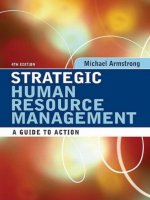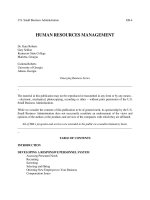human resources management _ section 3-staffing
Bạn đang xem bản rút gọn của tài liệu. Xem và tải ngay bản đầy đủ của tài liệu tại đây (2.52 MB, 51 trang )
Human Resource
Management
ESSENTIAL PERSPECTIVES
© 2005 Southwestern College Publishing. All rights reserved.
PowerPoint Presentation
by Truong Thi Lan Anh
Staffing the organization
Section 3
Robert L. Mathis John H. Jackson
© 2005 Southwestern College Publishing. All rights reserved. Lan Anh 8–2
Learning Objectives
After you have studied this section, you should be
able to:
– Discuss the advantages and disadvantages of internal and
external recruiting.
– Explain why Internet recruiting has grown and how
employers are conducting it.
– Discuss three factors to consider when evaluating
recruiting efforts.
– Describe why selection and placement must consider both
person-job and person-organization fit.
– Discuss several types of selection interviews and some
key considerations when conducting these interviews.
© 2005 Southwestern College Publishing. All rights reserved. Lan Anh 8–3
Strategic
Recruiting
Stages
Figure 7–1
© 2005 Southwestern College Publishing. All rights reserved. Lan Anh 8–4
Recruiting and Labor Markets
Recruiting
– The process of generating a pool of qualified
applicants for organizational jobs
Labor Markets
– The external supply pool from which organizations
attract their employees
Tight versus Loose Labor Markets
– Low unemployment creates competition for
employees, raising labor costs.
– High unemployment results the availability of more
applicants and more qualified applicants.
© 2005 Southwestern College Publishing. All rights reserved. Lan Anh 8–5
Recruiting Decisions
Recruiting method
– Advertising medium chosen, including use of
employment agencies
Recruiting message
– What is said about the job and how it is said
Applicant qualifications required
– Education level and amount of experience
necessary, for example
Administrative procedures
– When recruiting is done, applicant follow-up, and
use of previous applicant files
© 2005 Southwestern College Publishing. All rights reserved. Lan Anh 8–6
Labor Markets and Recruiting
Labor Market
Characteristics
Industry
and
Occupational
Markets
KSAs
Geographic
Markets
Local, Regional
National
International
Global
Educational
and
Technical
Markets
Qualifications
© 2005 Southwestern College Publishing. All rights reserved. Lan Anh 8–7
Strategic Recruiting Decisions
Organization-Based vs. Outsourced Recruiting
– HR knows organization best
– Outsourcing frees up time and decreases HR Staff
Professional Employer Organizations (PEOs)
and Employee Leasing
– Saves HR costs but increases total payroll costs
– Increases compliance with government regulations
and requirements.
– Benefits may be more available
© 2005 Southwestern College Publishing. All rights reserved. Lan Anh 8–8
Typical Division of HR Responsibilities: Recruiting
Figure 7–3
© 2005 Southwestern College Publishing. All rights reserved. Lan Anh 8–9
Effective Recruiting
Recruiting
Presence and Image
Training of
Recruiters
Regular vs. Flexible
Staffing
Effective
Recruiting
© 2005 Southwestern College Publishing. All rights reserved. Lan Anh 8–10
Regular vs. Flexible Staffing
Flexible Staffing
– The use of workers who are not traditional
employees.
– Temporary workers
• Hiring temporary staff members or contracting with
agencies supplying temporary workers on a rate-per-
day or rate-per-week basis.
– Independent contractors
• Workers who perform specific services on a contract
basis.
© 2005 Southwestern College Publishing. All rights reserved. Lan Anh 8–11
Advantages and Disadvantages of Internal
and External Recruiting Sources
Figure 7–5
© 2005 Southwestern College Publishing. All rights reserved. Lan Anh 8–12
Internal Recruiting
Organizational Databases
– Profiles containing background and KSA information
on current employees that allow for key word
searches to locate suitable candidates for open
positions and career development.
Job Posting
– A system in which the employer provides notices of
job openings and employees respond by applying.
Promotions and Transfers
– Upward and lateral movements of employees
© 2005 Southwestern College Publishing. All rights reserved. Lan Anh 8–13
Employee-Focused Recruiting
Current-Employee Referrals
– A reliable source composed of acquaintances,
friends, and family members of employees that are
recommended by current employees.
– Can violate EEO regulations if it is the sole source
of applicants.
Re-recruiting of Former Employees and
Applicants
– Individuals who have left for other jobs might be
willing to return.
© 2005 Southwestern College Publishing. All rights reserved. Lan Anh 8–14
External Recruiting
Employment Agencies
and Headhunters
College and
University Recruiting
High Schools and
Technical Schools
Labor
Unions
External
Recruiting
Sources
Media Sources
and Job Fairs
Competitive
Sources
© 2005 Southwestern College Publishing. All rights reserved. Lan Anh 8–15
What to Include in an Effective Recruiting Ad
Figure 7–6
© 2005 Southwestern College Publishing. All rights reserved. Lan Anh 8–16
Internet Recruiting Methods
Job Boards
Professional/
Career Web Sites
Employer Web Sites
E-Recruiting
Methods
© 2005 Southwestern College Publishing. All rights reserved. Lan Anh 8–17
Internet Recruiting (cont’d)
Advantages
– Recruiting cost savings
– Recruiting time savings
– Expanded pool of
applicants
– Morale building for current
employees
Disadvantages
– More unqualified
applicants
– Additional work for HR
staff members
– Many applicants are not
seriously seeking
employment
– Access limited or
unavailable to some
applicants
© 2005 Southwestern College Publishing. All rights reserved. Lan Anh 8–18
Recruiting Evaluation and Metrics
Evaluating
Recruiting
Satisfaction
Evaluating
Recruiting
Quality and
Quantity
Evaluating
the Time
Required to
Fill
Openings
Evaluating
Recruiting
Costs and
Benefits
Evaluating Recruiting Efforts
© 2005 Southwestern College Publishing. All rights reserved. Lan Anh 8–19
General Recruiting Process Metrics
Yield ratios
– A comparison of the number of applicants at one stage of the
recruiting process to the number at the next stage.
Selection rate
– The percentage hired from a given group of candidates.
Acceptance Rate
– The percent of applicants hired divided by total number of
applicants.
Success Base Rate
– Comparing the percentage rate of past applicants who were
good employees to that of current employees.
© 2005 Southwestern College Publishing. All rights reserved. Lan Anh 8–20
Sample
Recruiting
Evaluation
Pyramid
Figure 7–7
© 2005 Southwestern College Publishing. All rights reserved. Lan Anh 8–21
Selection
The process of choosing individuals who have
needed qualities to fill jobs in an organization.
Organizations need qualified employees to
succeed
–
“Good training will not make up for bad selection.”
–
“Hire hard, manage easy.”
© 2005 Southwestern College Publishing. All rights reserved. Lan Anh 8–22
Typical Division of HR Responsibilities: Selection
Figure 8–1
© 2005 Southwestern College Publishing. All rights reserved. Lan Anh 8–23
HR Employment Functions
Receiving applications
Interviewing applicants
Administering tests to
applicants
Conducting background
investigations
Arranging physical
examinations
Placing and assigning
new employees
Coordinating follow-up of
new employees
Exit interviewing
departing employees
Maintaining employee
records and reports.
© 2005 Southwestern College Publishing. All rights reserved. Lan Anh 8–24
Placement
Placement
– Fitting a person to the right job.
Person-job fit
– Matching the knowledge, skills and abilities (KSAs)
of people to the characteristics of jobs (tasks,
duties and responsibilities - TDRs).
– Benefits of person-job fit
• Higher employee performance
• Lower turnover and absenteeism
KSAs = TDRs = Job Success?
© 2005 Southwestern College Publishing. All rights reserved. Lan Anh 8–25
Person-Organization Fit
Figure 8–2









